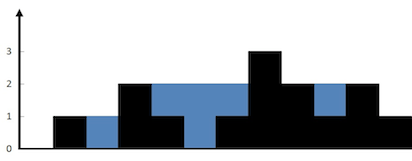Data Structure: Interview Experience Part 3 (Microsoft)
Data Structure: Interview Experience Part 3 (Microsoft)
Arrays & String

1.Given an array of integers, return indices of the two numbers such that they add up to a specific target.
You may assume that each input would have exactly one solution, and you may not use the same element twice.
Example:
Given nums = [2, 7, 11, 15], target = 9,
Because nums[0] + nums[1] = 2 + 7 = 9,
return [0, 1].
Practise: https://leetcode.com/problems/two-sum/
Complexity Analysis:
- Time complexity : O(n). We traverse the list containing n elements only once. Each look up in the table costs only O(1) time.
- Space complexity : O(n). The extra space required depends on the number of items stored in the hash table, which stores at most n elements.
2. Given a string, determine if it is a palindrome, considering only alphanumeric characters and ignoring cases.
Note: For the purpose of this problem, we define empty string as valid palindrome.
Example 1:
Input: "A man, a plan, a canal: Panama"
Output: true
Example 2:
Input: "race a car"
Output: false
Practise: https://leetcode.com/problems/valid-palindrome/
Complexity Analysis
- Time complexity : O(n), in length n of the string. We traverse over each character at-most once, until the two pointers meet in the middle, or when we break and return early.
- Space complexity : O(1). No extra space required, at all.
3. Implement
atoi which
converts a string to an integer.
The function first discards as many whitespace characters as necessary until the first non-whitespace character is found. Then, starting from this character, takes an optional initial plus or minus sign followed by as many numerical digits as possible, and interprets them as a numerical value.
The string can contain additional characters after those that form the integral number, which are ignored and have no effect on the behavior of this function.
If the first sequence of non-whitespace characters in str is not a valid integral number, or if no such sequence exists because either str is empty or it contains only whitespace characters, no conversion is performed.
If no valid conversion could be performed, a zero value is returned.
Note:
-
Only the space character
' 'is considered as whitespace character. - Assume we are dealing with an environment which could only store integers within the 32-bit signed integer range: [−231, 231 − 1]. If the numerical value is out of the range of representable values, INT_MAX (231 − 1) or INT_MIN (−231) is returned.
Practise: https://leetcode.com/problems/string-to-integer-atoi/
Example 1:
Input: "42"
Output: 42
Example 2:
Input: " -42"
Output: -42
Explanation: The first non-whitespace character is '-', which is the minus sign.
Then take as many numerical digits as possible, which gets 42.
Example 3:
Input: "4193 with words"
Output: 4193
Explanation: Conversion stops at digit '3' as the next character is not a numerical digit.
Example 4:
Input: "words and 987"
Output: 0
Explanation: The first non-whitespace character is 'w', which is not a numerical
digit or a +/- sign. Therefore no valid conversion could be performed.
4. Write a function that
reverses a string. The input string is given as an array of
characters
char[].
Do not allocate extra space for another array, you must do this by modifying the input array in-place with O(1) extra memory.
You may assume all the characters consist of printable ascii characters.
Example 1:
Input: ["h","e","l","l","o"]
Output: ["o","l","l","e","h"]
Example 2:
Input: ["H","a","n","n","a","h"]
Output: ["h","a","n","n","a","H"]
Practise: https://leetcode.com/problems/reverse-string/
5. Given an input string, reverse the string word by word.
Example 1:
Input: "the sky is blue"
Output: "blue is sky the"
Example 2:
Input: " hello world! "
Output: "world! hello"
Explanation: Your reversed string should not contain leading or trailing spaces.
Example 3:
Input: "a good example"
Output: "example good a"
Explanation: You need to reduce multiple spaces between two words to a single space in the reversed string.
Note:
- A word is defined as a sequence of non-space characters.
- Input string may contain leading or trailing spaces. However, your reversed string should not contain leading or trailing spaces.
- You need to reduce multiple spaces between two words to a single space in the reversed string.
Practise: https://leetcode.com/problems/reverse-words-in-a-string/
Complexity Analysis
- Time complexity: O(N).
- Space complexity: O(N).
6. Given an input string , reverse the string word by word.
Example:
Input: ["t","h","e"," ","s","k","y"," ","i","s"," ","b","l","u","e"]
Output: ["b","l","u","e"," ","i","s"," ","s","k","y"," ","t","h","e"]
Note:
- A word is defined as a sequence of non-space characters.
- The input string does not contain leading or trailing spaces.
- The words are always separated by a single space.
Follow up: Could you do it in-place without allocating extra space?
Practise: https://leetcode.com/problems/reverse-words-in-a-string-ii/
7. Given a string containing
just the characters
'(',
')',
'{',
'}',
'[' and
']',
determine if the input string is valid.
An input string is valid if:
- Open brackets must be closed by the same type of brackets.
- Open brackets must be closed in the correct order.
Note that an empty string is also considered valid.
Example 1:
Input: "()"
Output: true
Example 2:
Input: "()[]{}"
Output: true
Example 3:
Input: "(]"
Output: false
Example 4:
Input: "([)]"
Output: false
Example 5:
Input: "{[]}"
Output: true
Practise: https://leetcode.com/problems/valid-parentheses/
8. Given a string s, find the longest palindromic substring in s. You may assume that the maximum length of s is 1000.
Example 1:
Input: "babad"
Output: "bab"
Note: "aba" is also a valid answer.
Example 2:
Input: "cbbd"
Output: "bb"
Practise: https://leetcode.com/problems/longest-palindromic-substring/
9. Given an array of strings, group anagrams together.
Example:
Input:["eat", "tea", "tan", "ate", "nat", "bat"],
Output:
[
["ate","eat","tea"],
["nat","tan"],
["bat"]
]
Note:
- All inputs will be in lowercase.
- The order of your output does not matter.
Practise: https://leetcode.com/problems/group-anagrams/
10. Given n non-negative integers representing an elevation map where the width of each bar is 1, compute how much water it is able to trap after raining.

The above elevation map is represented by array [0,1,0,2,1,0,1,3,2,1,2,1]. In this case, 6 units of rain water (blue section) are being trapped. Thanks Marcos for contributing this image!
Example:
Input: [0,1,0,2,1,0,1,3,2,1,2,1]
Output: 6
Practise: https://leetcode.com/problems/trapping-rain-water/
Complexity analysis
- Time complexity: O(n). Single iteration of O(n).
- Space complexity: O(1) extra space.
11. Given a m x n matrix, if an element is 0, set its entire row and column to 0. Do it in-place.
Example 1:
Input:
[
[1,1,1],
[1,0,1],
[1,1,1]
]
Output:
[
[1,0,1],
[0,0,0],
[1,0,1]
]
Example 2:
Input:
[
[0,1,2,0],
[3,4,5,2],
[1,3,1,5]
]
Output:
[
[0,0,0,0],
[0,4,5,0],
[0,3,1,0]
]
Follow up:
- A straight forward solution using O(mn) space is probably a bad idea.
- A simple improvement uses O(m + n) space, but still not the best solution.
- Could you devise a constant space solution?
Practise: https://leetcode.com/problems/set-matrix-zeroes/
Complexity Analysis
- Time Complexity : O(M×N)
- Space Complexity : O(1)
12. You are given an n x n 2D matrix representing an image.
Rotate the image by 90 degrees (clockwise).
Note:
You have to rotate the image in-place, which means you have to modify the input 2D matrix directly. DO NOT allocate another 2D matrix and do the rotation.
Example 1:
Given input matrix =
[
[1,2,3],
[4,5,6],
[7,8,9]
],
rotate the input matrix in-place such that it becomes:
[
[7,4,1],
[8,5,2],
[9,6,3]
]
Example 2:
Given input matrix =
[
[ 5, 1, 9,11],
[ 2, 4, 8,10],
[13, 3, 6, 7],
[15,14,12,16]
],
rotate the input matrix in-place such that it becomes:
[
[15,13, 2, 5],
[14, 3, 4, 1],
[12, 6, 8, 9],
[16, 7,10,11]
]
Practise: https://leetcode.com/problems/rotate-image/
- Time complexity : O(N2).
- Space complexity : O(1) since we do a rotation in place.
13. Given a matrix of m x n elements (m rows, n columns), return all elements of the matrix in spiral order.
Example 1:
Input:
[
[ 1, 2, 3 ],
[ 4, 5, 6 ],
[ 7, 8, 9 ]
]
Output: [1,2,3,6,9,8,7,4,5]
Example 2:
Input:
[
[1, 2, 3, 4],
[5, 6, 7, 8],
[9,10,11,12]
]
Output: [1,2,3,4,8,12,11,10,9,5,6,7]
Practise: https://leetcode.com/problems/spiral-matrix/
Complexity Analysis
- Time Complexity: O(N), where N is the total number of elements in the input matrix. We add every element in the matrix to our final answer.
Space Complexity:
- O(1) without considering the output array, since we don’t use any additional data structures for our computations.
- O(N) if the output array is taken into account.
Hope this article is useful for people looking to learn and practice Data structure & Algorithm in swift, Please ❤️ to recommend this post to others 😊. Let me know your feedback. :)